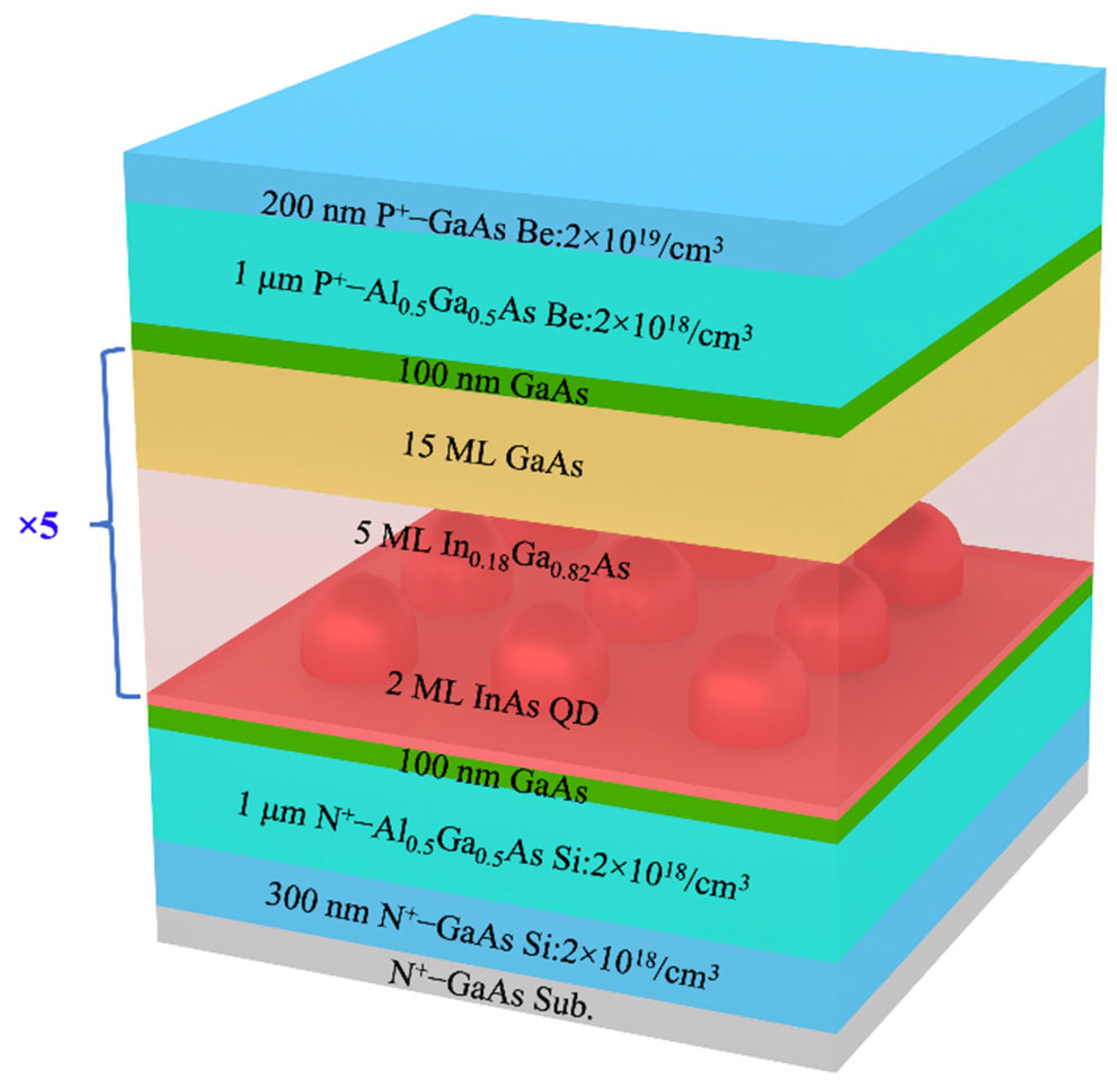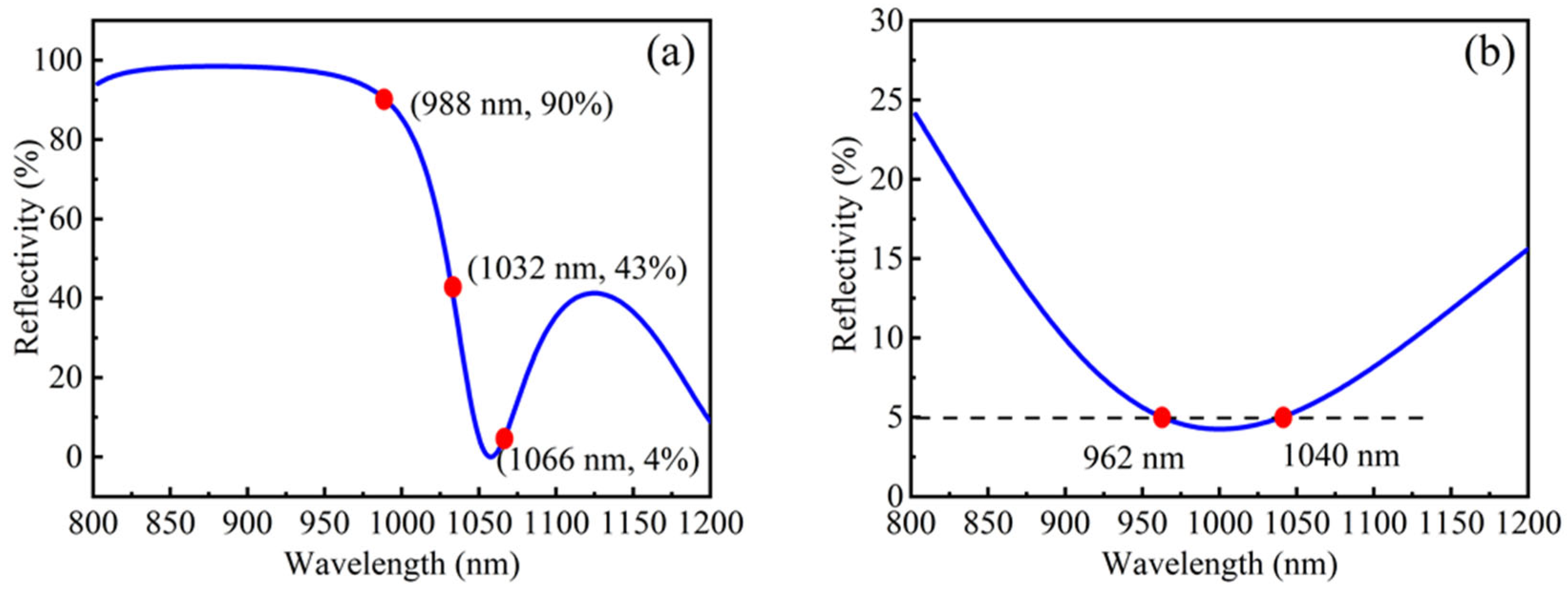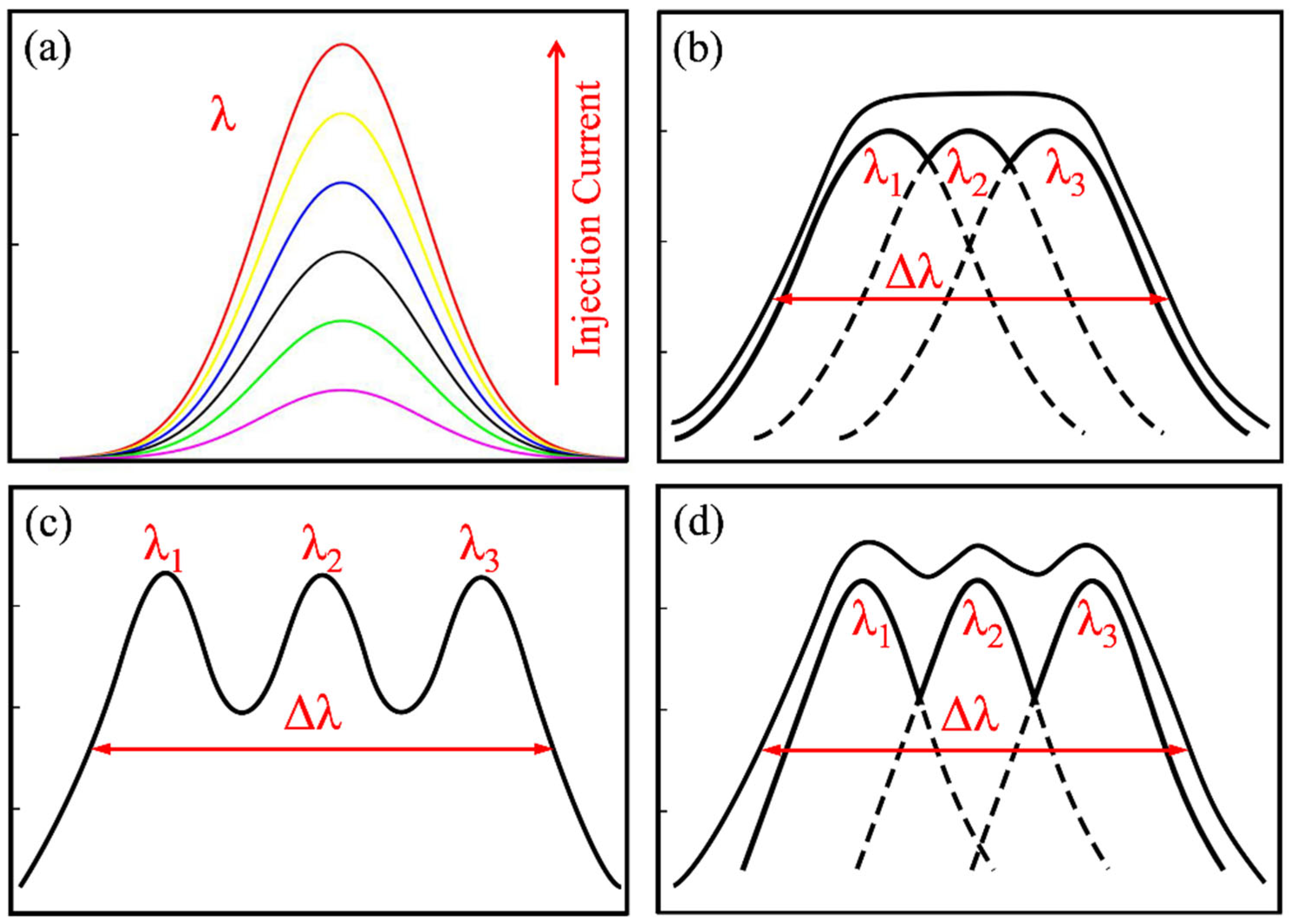Broadband Quantum Dot Superluminescent Diode with Simultaneous Three-State Emission
Abstract
:1. Introduction
2. Materials and Methods
3. Results and Discussion
4. Conclusions
Author Contributions
Funding
Institutional Review Board Statement
Informed Consent Statement
Data Availability Statement
Conflicts of Interest
References
- Alphonse, G.A.; Gilbert, D.B.; Harvey, M.G.; Ettenberg, M. High-power superluminescent diodes. IEEE J. Quantum Electron. 1988, 24, 2454–2457. [Google Scholar] [CrossRef]
- Huang, D.; Swanson, E.A.; Lin, C.P.; Schuman, J.S.; Stingson, W.G.; Chang, W.; Hee, M.R.; Flotte, T.; Gregory, K.; Puliafito, C.A.; et al. Optical coherence tomography. Science 1992, 254, 1178–1181. [Google Scholar] [CrossRef] [PubMed] [Green Version]
- Argyris, A.; Syvridis, D.; Larger, L.; Annovazzi-Lodi, V.; Colet, P.; Fischer, I.; Garcia-Ojalvo, J.; Mirasso, C.R.; Pesquera, L.; Shore, K.A. Chaos-based communications at high bit rates using commercial fibre-optic links. Nature 2005, 438, 343–346. [Google Scholar] [CrossRef] [PubMed]
- Zhang, Z.Y.; Hogg, R.A.; Xu, B.; Jin, P.; Wang, Z.G. Realization of extremely broadband quantum-dot superluminescent light-emitting diodes by rapid thermal-annealing process. Opt. Lett. 2008, 33, 1210–1212. [Google Scholar] [CrossRef]
- Zhang, Z.Y.; Jiang, Q.; Luxmoore, I.J.; Hogg, R.A. A p-type-doped quantum dot superluminescent LED with broadband and flat-topped emission spectra obtained by post-growth intermixing under a GaAs proximity cap. Nanotechnology 2009, 20, 055204. [Google Scholar] [CrossRef]
- Seddon, A.B. Mid-infrared (IR)—A hot topic: The potential for using mid-IR light for non-invasive early detection of skin cancer in vivo. Phys. Status Solidi B 2013, 250, 1020–1027. [Google Scholar] [CrossRef]
- Hou, C.C.; Chen, H.M.; Zhang, J.C.; Zhuo, N.; Huang, Y.Q.; Hogg, R.A.; Childs, D.T.D.; Ning, J.Q.; Wang, Z.G.; Liu, F.Q.; et al. Near-infrared and mid-infrared semiconductor broadband light emitters. Light Sci. Appl. 2018, 7, 17170. [Google Scholar] [CrossRef]
- Li, X.K.; Jin, P.; An, Q.; Wang, Z.C.; Lv, X.Q.; Wei, H.; Wu, J.; Wu, J.; Wang, Z.G. A high-performance quantum dot superluminescent diode with a two-section structure. Nanoscale Res. Lett. 2012, 6, 625. [Google Scholar] [CrossRef] [Green Version]
- Chen, S.M.; Zhou, K.J.; Zhang, Z.Y.; Orchard, J.R.; Childs, D.T.D.; Hugues, M.; Wada, O.; Hogg, R.A. Hybrid quantum well/quantum dot structure for broad spectral bandwidth emitters. IEEE J. Sel. Top. Quant. 2013, 19, 1900209. [Google Scholar] [CrossRef]
- Heo, D.C.; Song, J.D.; Choi, W.J.; Lee, J.I.; Jung, J.C.; Han, I.K. High power broadband InGaAs/GaAs quantum dot superluminescent diodes. Electron. Let. 2003, 39, 863–865. [Google Scholar] [CrossRef]
- Zhang, Z.Y.; Wang, Z.G.; Xu, B.; Jin, P.; Sun, Z.Z.; Liu, F.Q. High-performance quantum-dot superluminescent diodes. IEEE Photonics Technol. Let. 2004, 16, 27–29. [Google Scholar] [CrossRef]
- Zhang, Z.Y.; Hogg, R.A.; Jin, P.; Choi, T.L.; Xu, B.; Wang, Z.G. High-power quantum-dot superluminescent LED with broadband drive current insensitive emission spectra using a tapered active region. IEEE Photonics Technol. Let. 2008, 20, 782–784. [Google Scholar] [CrossRef]
- Chen, S.M.; Li, W.; Zhang, Z.Y.; Childs, D.; Zhou, K.; Orchard, J.; Kennedy, K.; Hugues, M.; Clarke, E.; Ross, I.; et al. GaAs-Based Superluminescent Light-Emitting Diodes with 290-nm Emission Bandwidth by Using Hybrid Quantum Well/Quantum Dot Structures. Nnaoscale Res. Lett. 2015, 10, 340. [Google Scholar] [CrossRef] [PubMed] [Green Version]
- Majid, M.A. High-performance GaAs-based superluminescent diode with 292-nm emission bandwidth using simple dot-in-a-well structures. J. Nanophotonics 2018, 12, 026007. [Google Scholar]
- Ledentsov, N.N.; Kirstaedter, N.; Grundmann, M.; Bimberg, D.; Ustinov, V.M.; Kochnev, I.V.; Kop’ev, P.S.; Alferov, Z.L. Three-dimensional arrays of self-ordered quantum dots for laser applications. Microelectron. J. 1997, 28, 915–993. [Google Scholar] [CrossRef]
- Ho, J.F.; Tatebayashi, J.; Sergent, S.; Fong, C.F.; Ota, Y.; Iwamoto, S.; Arakawa, Y.A. Nanowire-based plasmonic quantum dot Laser. Nano Lett. 2016, 16, 2845–2850. [Google Scholar] [CrossRef]
- Jiang, C.; Ning, J.Q.; Li, X.H.; Wang, X.; Zhang, Z.Y. Development of a 1550-nm InAs/GaAs quantum dot saturable absorber mirror with a short-period superlattice capping structure towards femtosecond fiber laser applications. Nanoscale Res. Lett. 2019, 14, 362. [Google Scholar] [CrossRef]
- Sun, Z.Z.; Ding, D.; Gong, D.; Zhou, W.; Xu, B.; Wang, Z.G. Quantum-dot superluminescent diode: A proposal for an ultra-wide output spectrum. Opt. Quantum Electron. 1999, 31, 1235–1246. [Google Scholar] [CrossRef]
- Lv, X.Q.; Liu, N.; Jin, P.; Wang, Z.G. Broadband emitting superluminescent diodes with InAs quantum dots in AlGaAs matrix. IEEE Photonics Technol. Lett. 2008, 20, 1742–1744. [Google Scholar] [CrossRef]
- Jiang, Q.; Zhang, Z.Y.; Hopkinson, M.; Hogg, R.A. High performance intermixed p-doped quantum dot superluminescent diodes at 1.2 µm. Electron. Lett. 2010, 46, 295–296. [Google Scholar] [CrossRef]
- Xin, Y.C.; Martinez, A.; Saiz, T.; Moscho, A.J.; Li, Y.; Nilsen, T.A.; Gray, A.L.; Lester, L.F. 1.3-μm quantum-dot multisection superluminescent diodes with extremely broad bandwidth. IEEE Photonics Technol. Lett. 2007, 19, 501–503. [Google Scholar] [CrossRef]
- Rossetti, M.; Li, L.H.; Markus, A.; Fiore, A.; Occhi, L.; Vélez, C.; Mikhrin, S.; Krestnikov, I.; Kovsh, A. Characterization and Modeling of Broad Spectrum InAs–GaAs Quantum-Dot Superluminescent Diodes Emitting at 1.2–1.3 μm. IEEE J. Quantum Electron. 2007, 43, 676–686. [Google Scholar] [CrossRef]
- Zhang, Z.Y.; Hogg, R.A.; Lv, X.Q.; Wang, Z.G. Self-assembled quantum-dot superluminescent light-emitting diodes. Adv. Opt. Photonics 2010, 2, 201–228. [Google Scholar] [CrossRef]
- Ray, S.K.; Groom, K.M.; Beattie, M.D.; Liu, H.Y.; Hopkinson, M.; Hogg, R.A. Broad-band superluminescent light-emitting diodes incorporating quantum dots in compositionally modulated quantum wells. IEEE Photonics Technol. Let. 2006, 18, 58–60. [Google Scholar] [CrossRef]
- Haffouz, S.; Raymond, S.; Lu, Z.G.; Barrios, P.J.; Roy-Guay, D.; Wu, X.; Liu, J.R.; Poitras, D.; Wasilewski, Z.R. Growth and fabrication of quantum dots superluminescent diodes using the indium-flush technique: A new approach in controlling the bandwidth. J. Cryst. Growth 2009, 311, 1803–1806. [Google Scholar] [CrossRef]
- Zhang, Z.Y.; Jiang, Q.; Hopkinson, M.; Hogg, R.A. Effects of intermixing on modulation p-doped quantum dot superluminescent light emitting diodes. Opt. Express 2010, 18, 7055–7063. [Google Scholar] [CrossRef]
- Chia, C.K.; Chua, S.J.; Dong, J.R.; Teo, S.L. Ultrawide band quantum dot light emitting device by postfabrication laser annealing. Appl. Phys. Lett. 2007, 90, 061101. [Google Scholar] [CrossRef]
- Xin, Y.C.; Li, Y.; Martinez, A.; Rotter, T.J.; Su, H.; Zhang, A.L.; Gray, S.; Luong, K.; Sun, Z.; Zou, J.Z.; et al. Optical gain and absorption of quantum dots measured using an alternative segmented contact method. IEEE J. Quantum Electron. 2006, 42, 725–732. [Google Scholar] [CrossRef]
- Hou, C.C.; Sun, J.L.; Ning, J.Q.; Zhang, J.C.; Zhuo, N.; Chen, H.M.; Liu, Q.L.; Zhao, Z.Y.; Wang, Z.G.; Zhang, Z.Y.; et al. High Power Compact Quantum Cascade Superluminescent Emitters with High Temperature Stability and Optical Beam Quality. J. Nanosci. Nanotechnol. 2018, 18, 7430–7434. [Google Scholar] [CrossRef]
- Park, G.; Shchekin, O.B.; Deppe, D.G. Temperature dependence of gain saturation in multilevel quantum dot lasers. IEEE J. Quantum Electron. 2000, 36, 1065–1071. [Google Scholar] [CrossRef]
- Yao, Z.H.; Wang, X.; Chen, H.M.; Wang, T.; Qin, L.; Liu, J.; Zhang, Z.Y. Carrier dynamics and lasing behavior of InAs/GaAs quantum dot lasers with short cavity lengths. Nanotechnology 2022, 33, 035201. [Google Scholar] [CrossRef] [PubMed]
- Markus, A.; Chen, J.X.; Paranthoën, C.; Fiore, A.; Platz, C.; Gauthier-Lafaye, O. Simultaneous two-state lasing in quantum-dot lasers. Appl. Phys. Lett. 2003, 82, 1818–1820. [Google Scholar] [CrossRef]
- Greenwood, P.D.L.; Childs, D.T.D.; Groom, K.M.; Stevens, B.J.; Hopkinson, M.; Hogg, R.A. Tuning Superluminescent Diode Characteristics for Optical Coherence Tomography Systems by Utilizing a Multicontact Device Incorporating Wavelength-Modulated Quantum Dots. IEEE J. Sel. Top. Quantum Electron. 2009, 15, 757–763. [Google Scholar] [CrossRef]






Publisher’s Note: MDPI stays neutral with regard to jurisdictional claims in published maps and institutional affiliations. |
© 2022 by the authors. Licensee MDPI, Basel, Switzerland. This article is an open access article distributed under the terms and conditions of the Creative Commons Attribution (CC BY) license (https://creativecommons.org/licenses/by/4.0/).
Share and Cite
Jiang, C.; Wang, H.; Chen, H.; Dai, H.; Zhang, Z.; Li, X.; Yao, Z. Broadband Quantum Dot Superluminescent Diode with Simultaneous Three-State Emission. Nanomaterials 2022, 12, 1431. https://doi.org/10.3390/nano12091431
Jiang C, Wang H, Chen H, Dai H, Zhang Z, Li X, Yao Z. Broadband Quantum Dot Superluminescent Diode with Simultaneous Three-State Emission. Nanomaterials. 2022; 12(9):1431. https://doi.org/10.3390/nano12091431
Chicago/Turabian StyleJiang, Cheng, Hongpei Wang, Hongmei Chen, Hao Dai, Ziyang Zhang, Xiaohui Li, and Zhonghui Yao. 2022. "Broadband Quantum Dot Superluminescent Diode with Simultaneous Three-State Emission" Nanomaterials 12, no. 9: 1431. https://doi.org/10.3390/nano12091431
APA StyleJiang, C., Wang, H., Chen, H., Dai, H., Zhang, Z., Li, X., & Yao, Z. (2022). Broadband Quantum Dot Superluminescent Diode with Simultaneous Three-State Emission. Nanomaterials, 12(9), 1431. https://doi.org/10.3390/nano12091431





